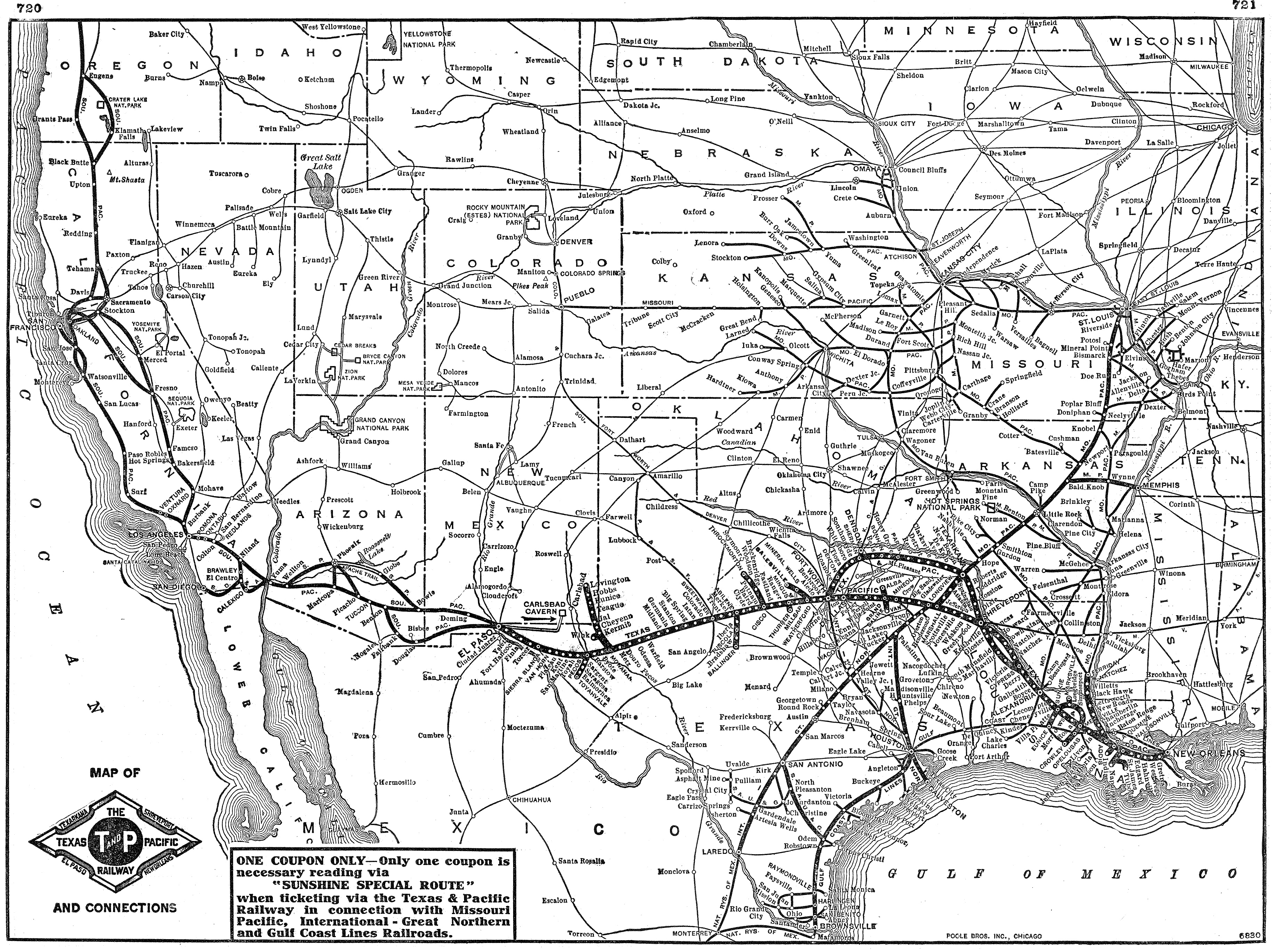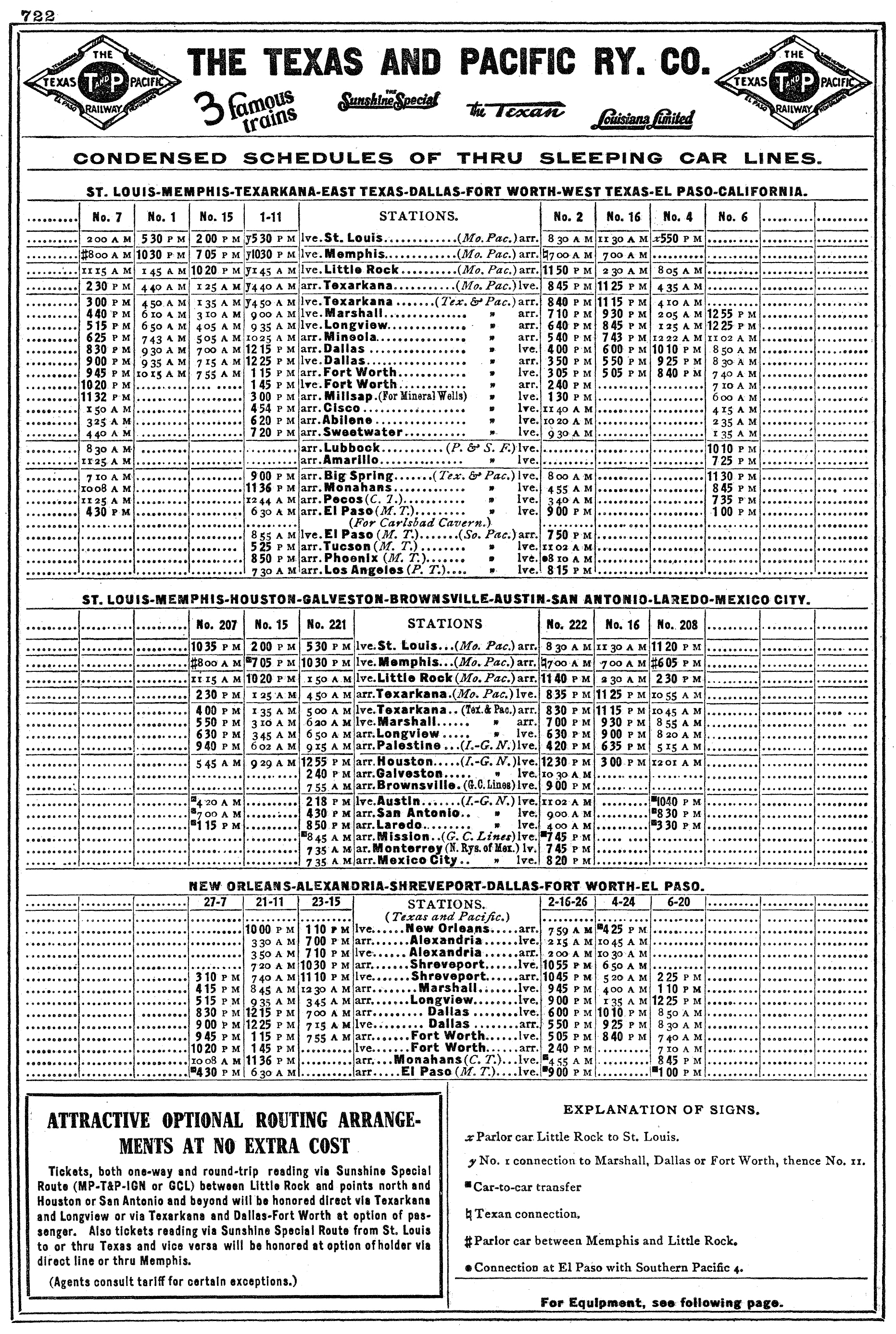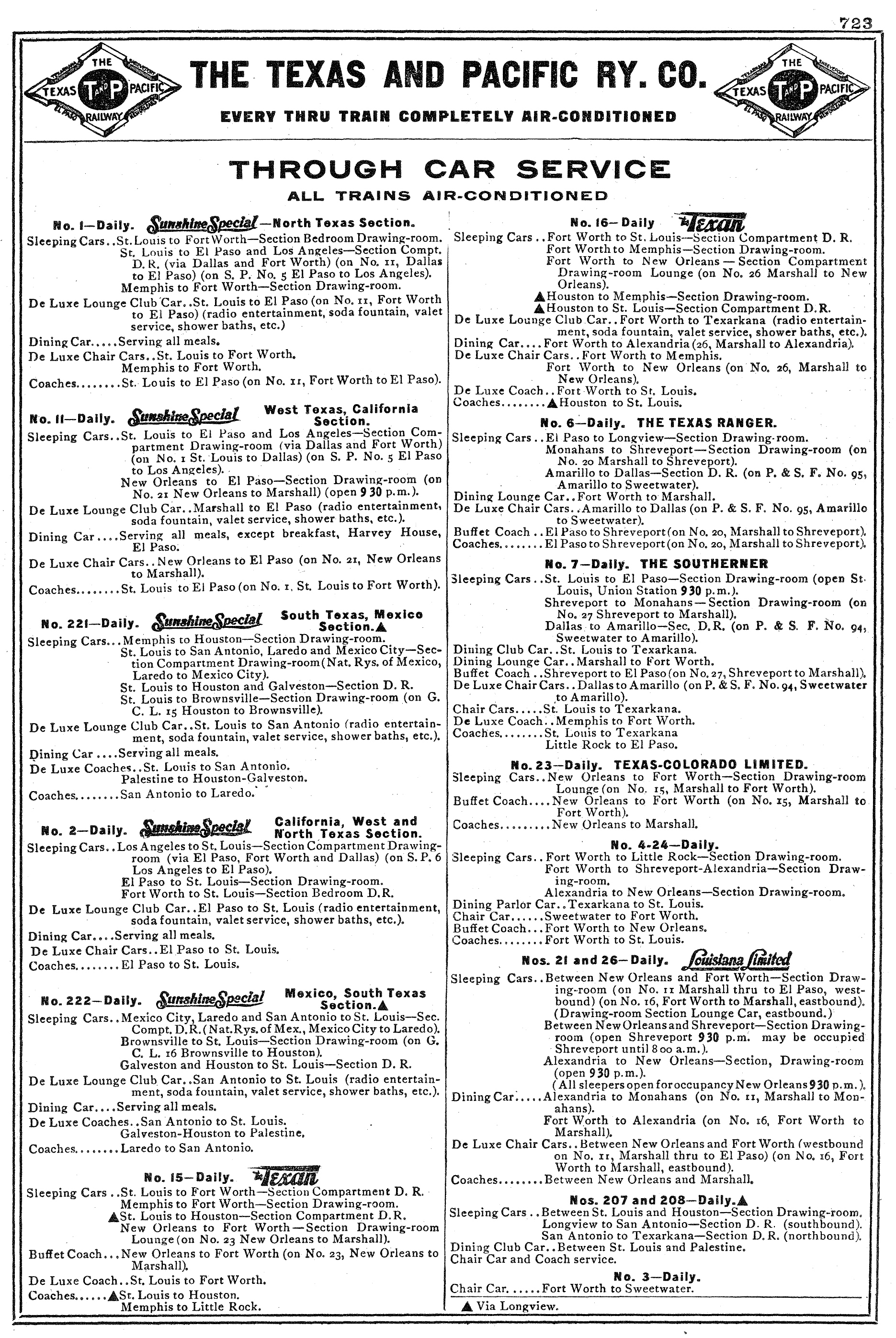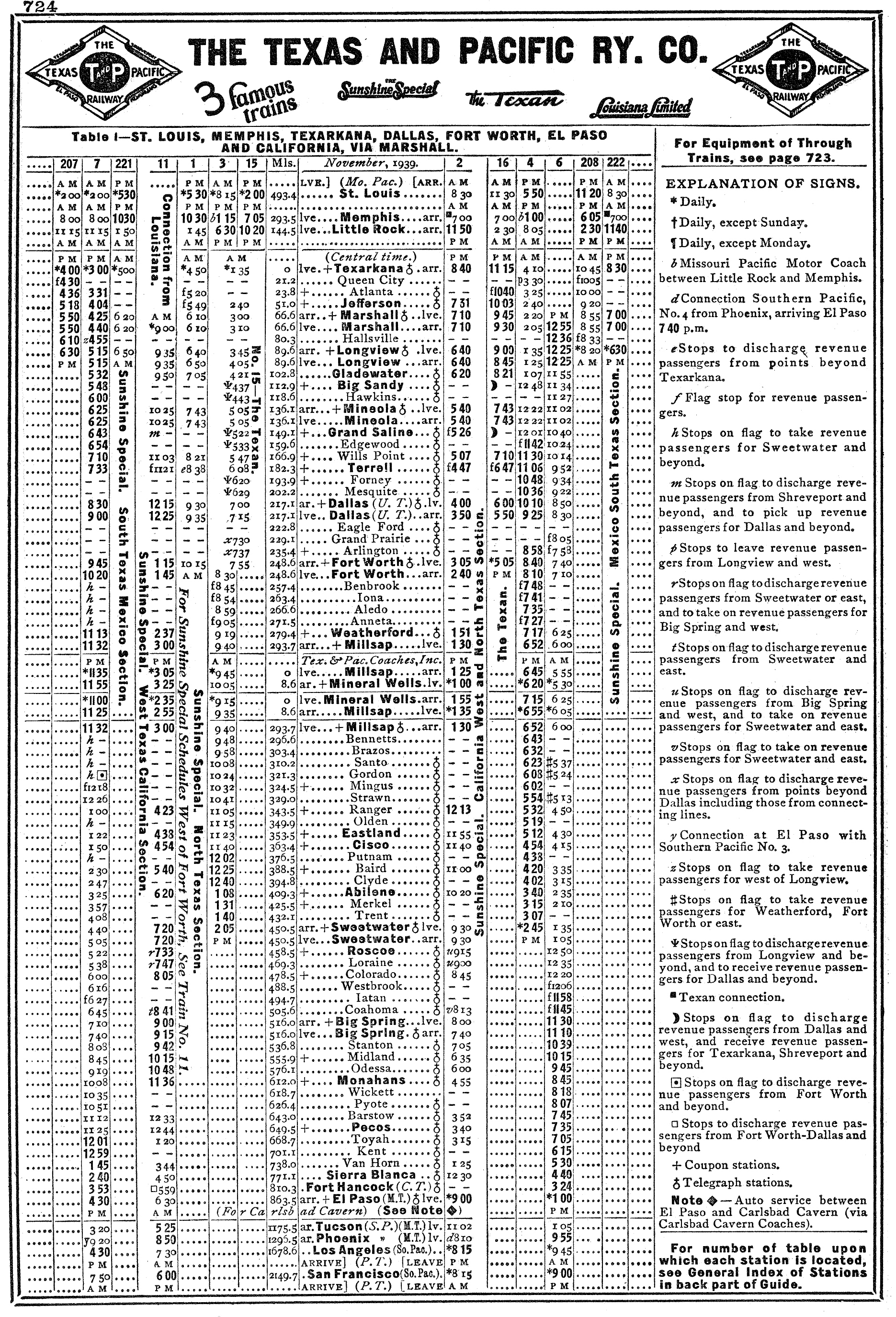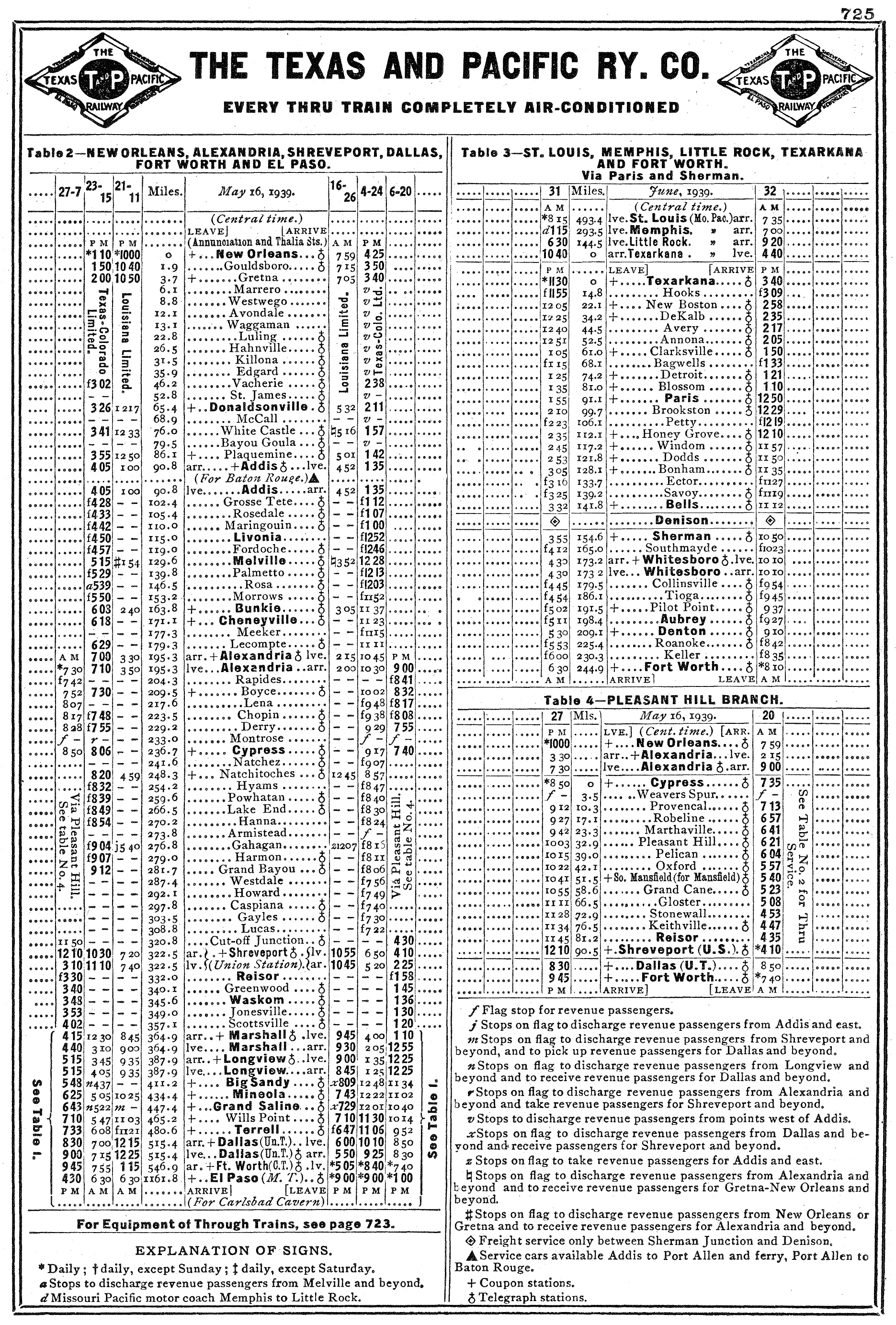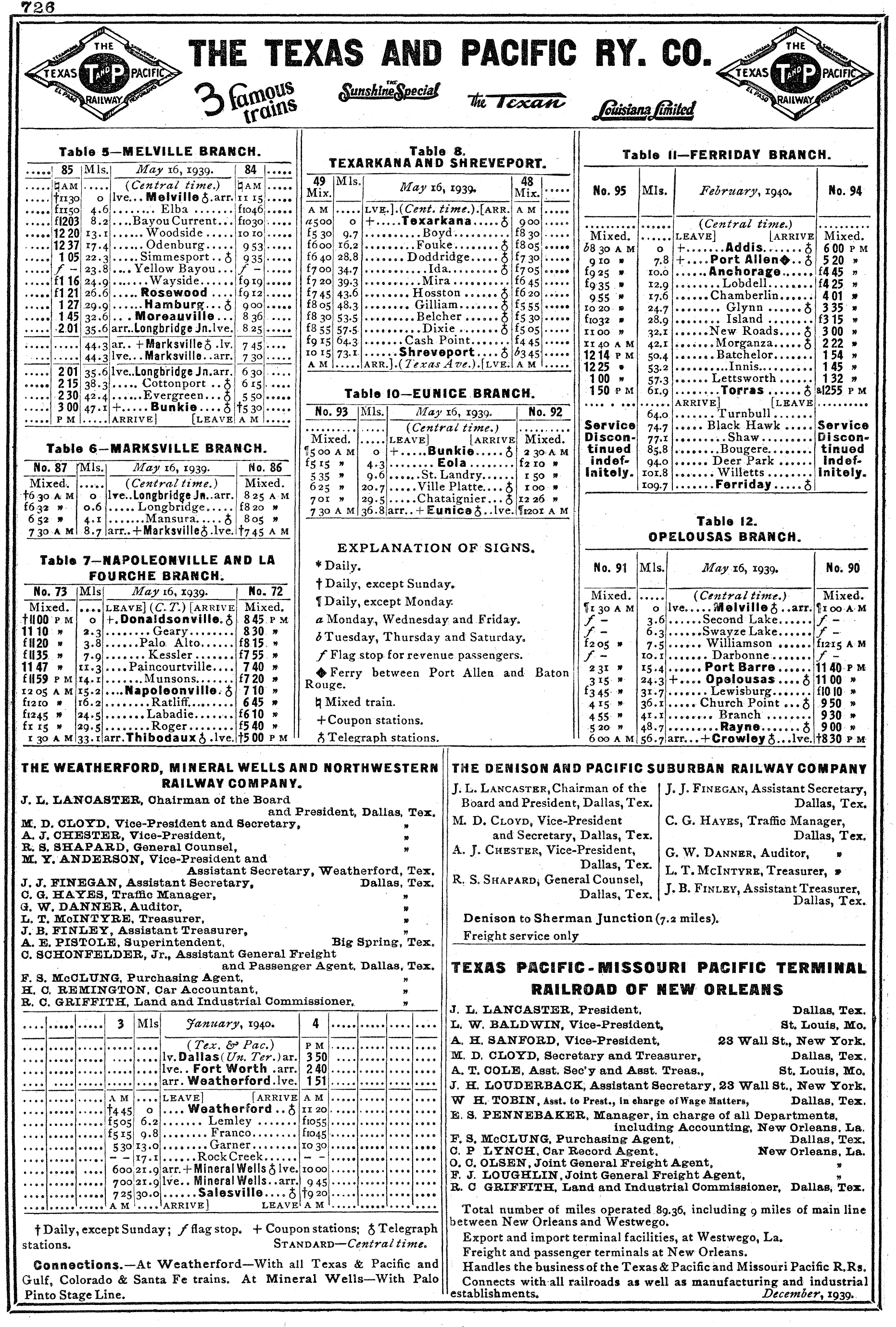Texas and Pacific Railway: Map, History, Timetables
Last revised: January 7, 2025
By: Adam Burns
Of all the Missouri Pacific's many subsidiaries, none were quite as important to its modern network as the Texas and Pacific Railway (T&P). It was initially established by Congress to construct a southern transcontinental corridor.
The road was originally chartered under a different name in 1871 and then became the T&P the following year. Before the decade had ended it was under Jay Gould's control and joined his growing Missouri Pacific empire.
At its peak, the T&P operated nearly 2,000 route miles linking New Orleans with El Paso, Texas via Dallas/Fort Worth. The system comprised most of the modern MP's network in the Gulf Coast region and Texas.
In addition, it competed with the Southern Pacific and Santa Fe but also interchanged with the former at El Paso to move transcontinental traffic.
From a historical perspective, the Texas & Pacific is an important footnote in American railroading as one of the few federally chartered systems to actually be built, and at least partially completed. Today, the railroad's former main line is still active under Union Pacific.
Photos
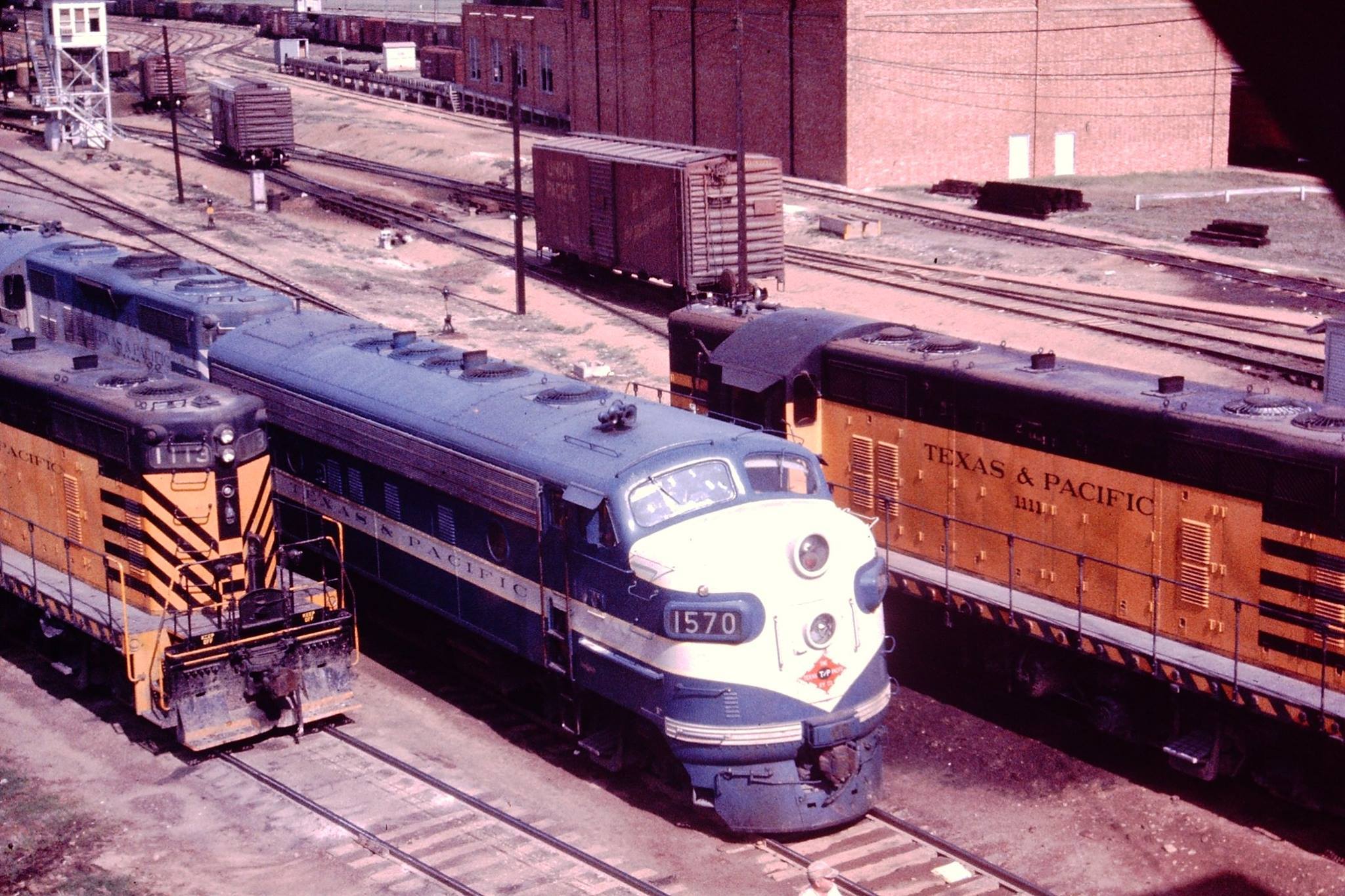 Texas & Pacific F7A #1570 and GP7s in a scene that probably dates to either the 1950s or early 1960s in Fort Worth. Nathan Edmonson photo/John Edmonson collection.
Texas & Pacific F7A #1570 and GP7s in a scene that probably dates to either the 1950s or early 1960s in Fort Worth. Nathan Edmonson photo/John Edmonson collection.History
The Texas & Pacific's origins begin on March 3, 1871 when Congress awarded the then-Texas Pacific Railroad a rare federal charter to establish a southern transcontinental route along the 32nd parallel from Marshall, Texas to San Diego, California.
At this time, the federal government was attempting to open other areas of the west to development; the original Transcontinental Railroad had been completed in 1869 and the hope was to establish northern and southern routes as well.
To do so, the government lured potential projects with land grants, essentially free property which could be used to establish rights-of-way and as monetary capital.
The government awarded twenty sections per mile through California and forty sections within the present-day states of Arizona and New Mexico.
In addition, Texas awarded twenty sections per mile within its borders. On May 2, 1872 the company's name was changed to the Texas & Pacific Railway and just a year later, the first segment between Marshall and Texarkana was completed (December 28, 1873).
System Map (1940)
While the T&P struggled to secure the necessary funding early on, it was lead by several eastern capitalists who had the connections to keep the project on track.
These individuals included former Texas Governor James Throckmorton, Moses Taylor, Samuel Tilden, E.W. Rice, and Thomas A. Scott.
Scott would subsequently recruit noted engineer Greenville Dodge, who had stepped in to help complete the Union Pacific leg of the Transcontinental Railroad.
Dodge brought strong military leadership, just as he had done at Union Pacific, and quickly completed the initial segment. At Longview, the T&P opened a connection with the International-Great Northern which provided through service to points throughout southern Texas, including Houston and San Antonio/Laredo.
In addition, at Texarkana interchange was established with St. Louis Iron Mountain & Southern Railway (StLIM&S), which offered through service into St. Louis.
At A Glance
Eastern Division (Via Marshall) Transcontinental Division (Via Sherman) Louisiana Division Rio Grande Division Avoyelles Division Texarkana District (T.C. Division) | |
Port Allen Branch La Fourche Branch Eunice Branch Melville Branch Napoleonville Branch Marksville Branch Ferriday Branch Opelousas Branch | |
The three roads worked together closely and comprised virtually all of the later Missouri Pacific's lines south of St. Louis.
As the roads began to flourish, Jay Gould became involved during the fall of 1879 and gained lease of the Texas & Pacific, through the Missouri Pacific, in 1881. The International-Great Northern had been added to his empire in December, 1880 while the StLIM&S was acquired in December, 1883.
Under his direction the T&P continued its westward march, reaching Sierra Blanca in West Texas on December 16, 1881 with a goal of connecting to the Southern Pacific at El Paso. Unfortunately, this was not to be.
The SP, led by Collis P. Huntington, had arrived there a few months earlier on May 19th, then continued building east, reaching Sierra Blanca on November 25th.
Timetables (1940)
By extending much further than what had been stipulated, Gould took Huntington to court. The fight was finally resolved when the "Gould-Huntington Agreement" was signed on November 26, 1881.
This accord gave the T&P trackage rights over the Southern Pacific into El Paso but also forfeited its charter and franchises west of that point which were awarded to SP. Following the settlement, construction continued eastward with the railroad arriving in New Orleans on September 12, 1882.
In the succeeding years the T&P continued expanding, most notably to Denison (opening an interchange there with the Missouri, Kansas & Texas) and a secondary line into Texarkana that passed through Paris. At its peak the T&P owned 1,982-miles, including 1,109 miles in Texas.
As-mentioned, the T&P held a principal connection with the International & Great Northern at Longview and the St. Louis Iron Mountain & Southern Railway at Texarkana. For a fascinating background of this carrier, and how it wound up under Gould's direction, purchase a copy of "The Texas Railroad: The Scandalous And Violent History Of The International And Great Northern Railroad, 1866-1925" by Wayne Cline.
Missouri Pacific
Following Jay Gould's control of the Missouri Pacific, along with his son George, the railroad has blossomed into a nearly 10,000 mile network by the turn of the 20th century.
The MP stretched from St. Louis to Pueblo (and a connection into Denver), Omaha (Nebraska), most of Texas, Memphis, and New Orleans.
However, it was laden with heavy debt from the Gould era. As a result, it wasn't able to transform itself into a modern, respectable, and profitable carrier until after the Great Depression.
Interestingly, the Texas and Pacific remained a separate corporate entity throughout most of the 20th century. The T&P, which even had its own offices and station in downtown Fort Worth (completed in 1931 by Wyatt C. Hedrick in the Art Deco style), and still stands today, formerly disappeared into the Missouri Pacific on October 15, 1976.
Diesel Roster
Electro-Motive (EMD)
| Model Type | Road Number (1st) | Road Number (2nd) | Serial Number | Date Built | Quantity |
|---|---|---|---|---|---|
| GP35 | 600-614 | 2500-2513 (former 600-613) | 28772-28786 | 12/1963-1/1964 | 15 |
| GP35 | 640-649 | 2537-2546 | 29820-29829 | 3/1965-4/1965 | 10 |
| SD40-2 | 790-794 | 3090-3094 | 73713-1 thru 73713-5 | 8/1973 | 5 |
| SW8 | 811-818 | 1401-1404, 1406, 1409, 1414, 1416 | 15830-15837 | 1/1952 | 8 |
| SD40-2 | 816-839 | 3115-3138 | 73648-1 thru 73648-24 | 12/1973-1/1974 | 24 |
| NW2 | 1000-1001 | - | 3963-3964 | 10/1946 | 2 |
| NW2 | 1002-1008 | - | 4588-4594 | 1/1947-2/1947 | 7 |
| NW2 | 1009-1019 | - | 6581-6591 | 9/1948-5/1949 | 11 |
| SW7 | 1020-1023 | 1202-1203 (former 1021-1022), 1415 (former 1023), 1417 (former 1020) | 11996-11999 | 7/1950 | 4 |
| SW9 | 1024-1028, 1029-1036 | 1222-1231 (former 1027-1036), 1410 (former 1033), 1412 (former 1026), 1419 (former 1024), 1422 (former 1025) | 14022-14026, 14510-14517 | 2/1951, 7/1951-8/1951 | 13 |
| GP7 | 1110-1116 | - | 11018-11024 | 3/1950 | 7 |
| GP7 | 1117 | - | 14020 | 4/1951 | 1 |
| GP7 | 1118-1119 | 627-628 | 14021, 14550 | 4/1951, 8/1951 | 2 |
| GP7 | 1120-1124 | 1629-1630 (former 1120-1121), 1633 (former 1124) | 14551-14555 | 4/1951 | 5 |
| GP7 | 1125-1130 | 641-643 (former 1125-1127), 1644 (former 1129) | 15824-15829 | 4/1952 | 6 |
| GP7 | 1131-1136, 1137-1144 | 1837-1849 (former 1131, 1133-44) | 22524-22529, 25345-25352 | 3/1957-5/1959 | 14 |
| GP18 | 1145-1149 | 1850-1854 | 25906-25910 | 5/1960 | 5 |
| F7A | 1520-1536 | 850-861, 862-886 | 11559-11575 | 7/1950 | 17 |
| F7A | 1537-1545 | 887-895 | 12029-12037 | 3/1951 | 9 |
| F7A | 1546-1553 | 896-903 | 12042-12049 | 4/1951 | 8 |
| F7A | 1554-1557 | 904-907 | 12038-12041 | 4/1951 | 4 |
| F7A | 1581-1582 | 931-932 | 15839-15840 | 1/1952 | 2 |
| F7B | 1500B-1515B | 850B-865B | 8440-8451, 8469-8463 | 2/1949-11/1949 | 16 |
| F7B | 1516B-1523B | 866B-873B | 11576-11577, 13516-13521 | 7/1950, 4/1951 | 8 |
| F7B | 1524B-1530B | - | 14541-14547 | 7/1951 | 7 |
| F7B | 1531B-1534B | - | 15841-15844 | 1/1952 | 4 |
| GP9m* | 1695-1696 | - | 17848-17849 | 1/1953-2/1953 | 2 |
* Ex-Midland Valley GP7's #152-153.
General Electric (GE)
| Model Type | Road Number (1st) | Road Number (2nd) | Serial Number | Date Built | Quantity |
|---|---|---|---|---|---|
| U30C | 970-973 | 2975-2978 | 37559-37562 | 6/1970-7/1970 | 4 |
| U30C | 3329-3334 | 2994-2999 | 39500-39504 | 1/1974-2/1974 | 6 |
Steam Roster
| Road Number | Wheel Arrangement | Class | Builder | Date Built |
|---|---|---|---|---|
| 1-3 | 4-4-0 | - | Rogers | 9/1869 |
| 2 (2nd) | 4-4-0 | A-1 | Danforth | 1900 |
| 3 (2nd) | 0-6-0 | B-5 | Texas & Pacific | 1907 |
| 4-6 | 4-4-0 | - | Pittsburgh | 9/1872 |
| 4-5 (2nds) | 0-6-0 | B-5 | Texas & Pacific | 1907 |
| 6 (2nd) | 4-6-0 | D-1 | - | - |
| 7 | 0-6-0 | B-2 | Baldwin | 8/1872 |
| 8-22 | 4-4-0 | A | Baldwin | 8/1872-8/1873 |
| 8 (2nd) | 0-6-0 | B-5 | Texas & Pacific | 1907 |
| 10 (2nd) | 0-6-0 | B-5 | Texas & Pacific | 1907 |
| 11 (2nd) | 4-4-0 | B-5 | Texas & Pacific | 1901 |
| 12 (2nd) | 4-4-0 | A-3 | Baldwin | 1872 |
| 14 (2nd) | 4-4-0 | A-3 | Schenectady | 1872 |
| 15 (2nd) | 0-6-0 | B-5 | Texas & Pacific | 1907 |
| 16-21 (2nd) | 4-4-0 | A-3 | Texas & Pacific | 1900 |
| 22-25, 27, 41, 46 (2nds) | 0-6-0 | B-5 | Texas & Pacific | 1902-1905 |
| 23-24 | 4-4-0 | - | Rogers | 9/1867 |
| 25-34 | 4-4-0 | A-1 | Pittsburgh | 7/1876-11/1876 |
| 31-34 (2nd) | 4-4-0 | A-3 | Texas & Pacific | 1900 |
| 35-39, 41-44, 45 (2nd) | 4-4-0 | A-3 | Baldwin | 8/1876-9/1876 |
| 40, 45-46 | 0-6-0 | B-3 | Pittsburgh | 8/1876 |
| 47-49, 51, 53-58 | 4-4-0 | A-2 | Schenectady | 4/1880-7/1880 |
| 50, 52 | 4-4-0 | - | Rogers | 1870 |
| 50 (2nd) | 4-4-0 | - | Baldwin | 1876 |
| 52 (2nd) | 0-6-0 | B-5 | Texas & Pacific | 1905 |
| 60, 70 | 4-4-0 | - | Grant | 1882 |
| 71-79 | 4-6-0 | D-2 | Pittsburgh | 6/1880-8/1880 |
| 80 | 4-4-0 | - | Rogers | 2/1871 |
| 80 (2nd) | 4-6-0 | D-2 | Pittsburgh | 10/1880 |
| 80 (3rd) | 4-4-0 | A-3 | Pittsburgh | 2/1882 |
| 81 | 4-4-0 | A-3 | Pittsburgh | 2/1882 |
| 81 (2nd) | 4-6-0 | D-2 | Pittsburgh | 10/1880 |
| 82-89, 91-92 | 4-6-0 | D-2 | Pittsburgh | 2/1881-4/1881 |
| 90 | 4-4-0 | A-3 | Pittsburgh | 2/1882 |
| 109-112 | 4-4-0 | A-3 | Schenectady | 7/1881 |
| 113-115 | 0-6-0 | B-5 | Texas & Pacific | 1901 |
| 116 | 4-4-0 | B-5 | Texas & Pacific | 1897 |
| 124-126 | 4-4-0 | A-3 | Pittsburgh | 2/1882 |
| 127-134, 140 | 0-6-0 | B-5 | Texas & Pacific | 1898-1901, 1907 |
| 135-139 | 4-4-0 | A-3 | Missouri Pacific | 9/1882-10/1882 |
| 141-160 | 2-6-0 | C-1 | Missouri Pacific | 4/1883-12/1883 |
| 161-168 | 4-6-0 | D-3 | Brooks | 12/1885-7/1886 |
| 169 | 0-6-0 | B-5 | Texas & Pacific | 1907 |
| 170-182 | 4-6-0 | D-4 | Rome | 12/1886-6/1887 |
| 183-185 | 0-6-0 | B-5 | Rome | 9/1887 |
| 186-188 | 4-4-0 | A-4 | Rome | 8/1887 |
| 189-238 | 4-6-0 | D-5 | Baldwin | 7/1889-7/1897 |
| 239-242 | 4-6-0 | D-7 | Baldwin | 12/1897 |
| 243-244, 264-266 | 4-6-0 | D-7 | Rogers | 1898-1900 |
| 245-256 | 4-6-0 | D-8 | Rogers | 1898-1899 |
| 257-263 | 4-6-0 | D-9 | Rogers | 1900 |
| 267-274 | 4-6-0 | D-7 | Alco/Cooke | 1901 |
| 275-316, 324-338 | 4-6-0 | D-9 | Alco/Cooke | 1901-5/1903 |
| 317-323 | 0-6-0 | B-6 | Alco/Cooke | 11/1902 |
| 339-340 | 4-4-2 | E-1 | Texas & Pacific | 1906-1907 |
| 339-358 | 4-6-0 | D-9 | Alco/Rogers | 12/1906 |
| 359-360 | 4-6-0 | D-9 | Texas & Pacific | 1907 |
| 361-400 | 4-6-0 | D-10 | Alco/Cooke | 10/1907 |
| 400 (2nd) | 2-8-2 | E4A1 | Baldwin | 1915 |
| 401-410 | 2-8-0 | F-1 | Baldwin | 7/1912 |
| 411-420 | 4-6-0 | D-11 | Baldwin | 6/1912 |
| 450-456 | 0-6-0 | B-7 | Baldwin | 1/1916 |
| 457-470 | 0-6-0 | B-8 | Alco/Pittsburgh | 3/1919 |
| 471-478 | 0-6-0 | B-8a | Alco/Cooke | 1/1923 |
| 480-481 | 0-8-0 | C-2a | Baldwin | 1/1926 |
| 482-489 | 0-8-0 | C-2 | Baldwin | 11/1925 |
| 490-491 | 0-8-0 | C-2a | Baldwin | 5/1927 |
| 492-494 | 0-8-0 | C-2 | Baldwin | 5/1927 |
| 500-505 | 2-10-2 | G-1 | Baldwin | 3/1916 |
| 506-513 | 2-10-2 | G-1a | Baldwin | 3/1917-6/1917 |
| 514-525 | 2-10-2 | G-1b | Baldwin | 4/1919 |
| 526-543 | 2-10-2 | G-1c | Alco/Brooks | 12/1919 |
| 550-560 | 2-8-2 | H-1 | Alco/Schenectady | 1918 |
| 600-606 (1st) | 4-6-2 | P-1 | Baldwin | 4/1919 |
| 600-606 (2nd) | 2-10-4 | I-1 | Lima | 10/1925 |
| 607-609 | 2-10-4 | I-1 | Lima | 10/1925 |
| 610-624 | 2-10-4 | I-1a | Lima | 6/1927 |
| 625-639 | 2-10-4 | I-1b | Lima | 2/1928 |
| 640-654 | 2-10-4 | I-1c | Lima | 6/1928 |
| 655-669 | 2-10-4 | I-1d | Lima | 1929 |
| 700-706 | 4-6-2 | P-1 | Baldwin | 1919 |
| 707-713 | 4-6-2 | P-1a | Alco/Brooks | 1919 |
| 714-721 | 4-6-2 | P-1b | Alco/Richmond | 3/1923 |
| 800-810 | 2-8-2 | H-2 | Baldwin | 7/1919 |
| 900-904 | 4-8-2 | M-1 | Alco/Schenectady | 11/1925 |
| 905-909 | 4-8-2 | M-2 | Baldwin | 6/1928 |
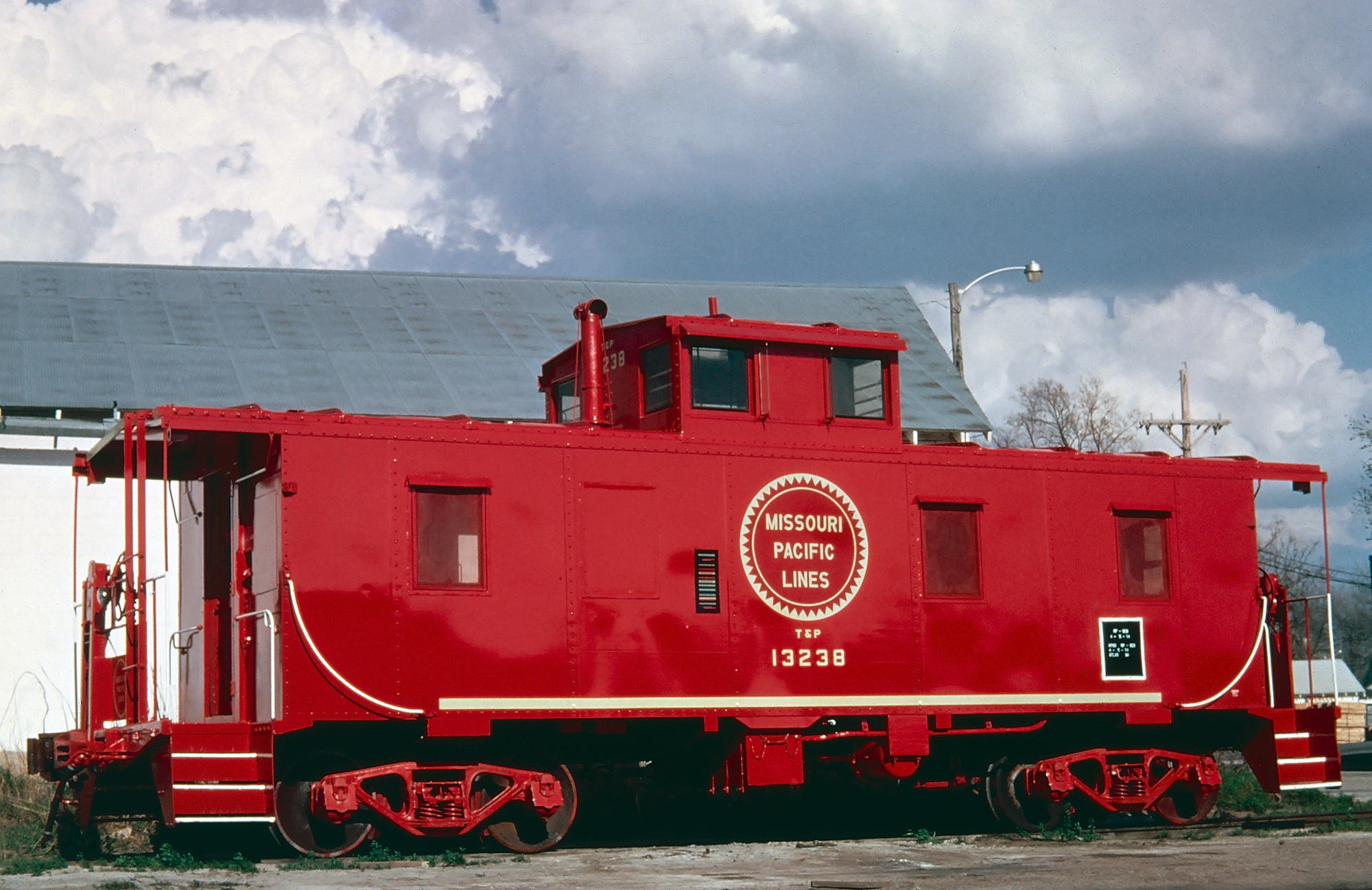 Missouri Pacific (Texas & Pacific) caboose #13238 in Kansas City; April, 1969. This car was a former Muskogee Road caboose, rebuilt by the shops in Sedalia, Missouri. American-Rails.com collection.
Missouri Pacific (Texas & Pacific) caboose #13238 in Kansas City; April, 1969. This car was a former Muskogee Road caboose, rebuilt by the shops in Sedalia, Missouri. American-Rails.com collection.Final Years
Only a few years later, in 1982, the MoPac was acquired by Union Pacific. In its final years the MP was a fine operation; in 1979 it had a net income of $32.6 million and gross revenues of over $524 million.
The Texas and Pacific lines were a primary reason for this, providing the MoPac with some of its largest markets. Since the T&P remained a separate entity for so long it is also well-remembered by railfans; the road had its own fleet of steam and diesel locomotives, in addition to a separate listing within the "Official Guide Of The Railways."
Today, the T&P's principal lines remain in active service under successor Union Pacific while other segments are still utilized by short lines.
Sources
- Ambrose, Stephen E. Men Who Built The Transcontinental Railroad, The: Nothing Like It In The World. New York: Simon & Schuster, 2000.
- Cline, Wayne. Texas Railroad, The: The Scandalous And Violent History Of The International And Great Northern Railroad, 1866-1925. Lexington: 2015.
- Klein, Maury. Life And Legend Of Jay Gould, The. Baltimore: The Johns Hopkins University Press, 1986.
- Schafer, Mike. More Classic American Railroads. Osceola: MBI Publishing, 2000.
Contents
Recent Articles
-
An Oregon Christmas Train Ride In Portland!
Nov 07, 25 12:18 AM
The ORHF's Holiday Express is more than a nostalgic train ride. It’s a fundraiser that directly supports the preservation work you see inside the enginehouse. -
An Hawaii Christmas Train Ride On Oahu!
Nov 06, 25 11:55 PM
When the Christmas season arrives, the Hawaiian Railway Society transforms their excursion experience into the Holiday Express—an illuminated, family-friendly ride that blends vintage railroading with… -
An Ohio Christmas Train Ride In Nelsonville!
Nov 06, 25 02:57 PM
Among the Hocking Valley Scenic Railway's most popular offerings is the Santa Train, a Christmastime tradition that sells out year after year and has become a cornerstone of the region’s holiday festi…

